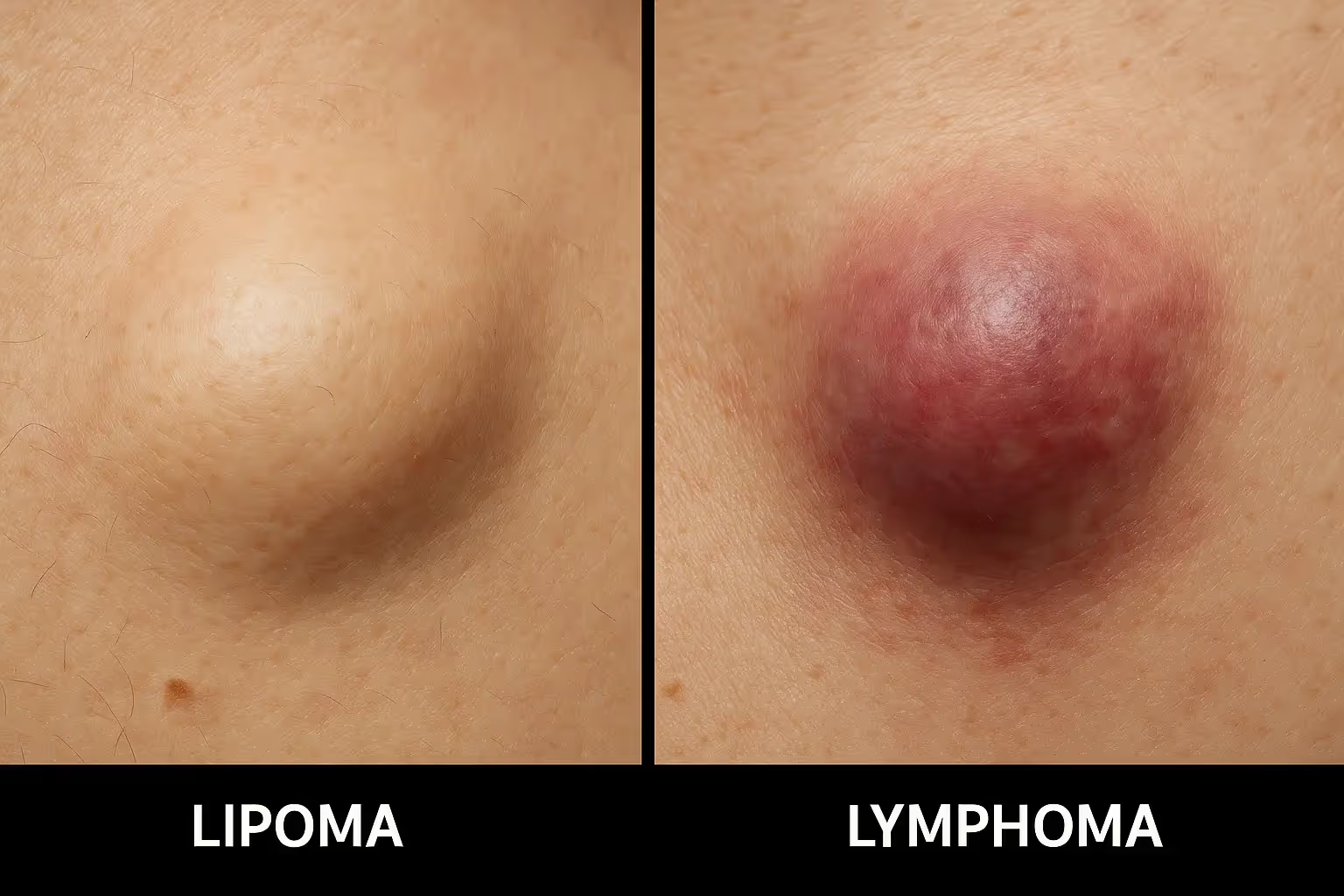When you notice a lump or growth under your skin, it's natural to feel concerned and wonder about its nature. While many lumps are harmless, such as lipomas (fatty growths), others may be more serious and require prompt medical attention. One condition that can sometimes be mistaken for a lipoma is lymphoma, a type of cancer that affects the lymphatic system.

In this article, we'll explore the key differences between lipomas and lymphomas, as well as the symptoms and diagnostic processes for each condition. Understanding these distinctions is crucial for seeking appropriate medical care and addressing any potential health concerns.
Lipomas are non-cancerous, fatty lumps that can develop anywhere on the body where there is adipose (fat) tissue. They are typically soft, movable, and painless, although larger lipomas can cause discomfort or impair mobility in certain areas.
Lipomas are generally harmless and can often be left alone if they are not causing any symptoms or cosmetic concerns. However, some individuals may choose to have them removed for cosmetic reasons or if they are causing discomfort or impaired mobility.
While lipomas are typically benign, it's essential to have any new lump or growth evaluated by a healthcare professional to rule out other potential conditions.
While most lipomas are classified as simple lipomas, there are several subtypes that can occur, including:
These subtypes may have slightly different characteristics or appearances on imaging studies, but the diagnostic process and treatment options are generally similar to those for simple lipomas.
Lymphomas are a type of cancer that affects the lymphatic system, which is a network of tissues and organs that play a crucial role in the body's immune response. Lymphomas can be broadly classified into two main types: Hodgkin lymphoma and non-Hodgkin lymphoma.
Unlike lipomas, lymphomas are malignant (cancerous) and can spread to other parts of the body if left untreated. Early detection and prompt treatment are essential for managing lymphomas and improving outcomes.
Lymphomas can cause lymph nodes to become enlarged, but they can also affect other organs, such as the spleen, bone marrow, or even the skin. The specific symptoms may vary depending on the type and stage of the lymphoma.
Lymphomas can be further classified into several subtypes based on the specific type of lymphocyte (a type of white blood cell) involved and the characteristics of the cancer cells. Some common types of lymphomas include:
The specific subtype of lymphoma can influence the treatment approach and prognosis, making accurate diagnosis and staging essential.

While both lipomas and lymphomas can present as lumps or growths, there are several key differences that can help distinguish between the two conditions:
It's important to note that while these differences can be helpful in distinguishing between lipomas and lymphomas, a proper diagnosis should always be made by a qualified healthcare professional through appropriate diagnostic tests and examinations.
If you notice a lump or growth under your skin, it's essential to have it evaluated by a healthcare professional to determine its nature and rule out any potential concerns. The diagnostic process for lipomas and lymphomas may involve several steps:
At The Minor Surgery Center, our board-certified plastic surgeons, Dr. Kunaal Jindal and Dr. Roberto Tutino, have extensive experience in diagnosing and treating lipomas. However, if there is any suspicion of a more serious condition, such as lymphoma, they will promptly refer you to an appropriate specialist for further evaluation and management.
The main difference is that lipomas are benign fat tumors that grow slowly and rarely cause problems, while lymphomas are cancerous growths in the lymphatic system that require immediate medical attention.
Seek urgent medical care if you notice rapid growth, hard/fixed lumps, night sweats, unexplained weight loss, persistent fever, or multiple enlarged lymph nodes.
The treatment approach for lipomas and lymphomas differs significantly due to the nature of these conditions.
While lipomas are generally harmless, they can cause discomfort, impair mobility, or lead to cosmetic concerns, depending on their size and location. Treatment options for lipomas may include:
Lymphomas are serious conditions that require prompt and aggressive treatment to manage the cancer and improve outcomes. The specific treatment approach will depend on the type and stage of the lymphoma, as well as the patient's overall health and other factors.
Common treatment options for lymphomas may include:
It's important to note that the treatment of lymphomas is a complex process that often involves a multidisciplinary team of healthcare professionals, including oncologists, radiologists, and other specialists.
When determining the most appropriate treatment option for a lipoma or lymphoma, healthcare providers will consider several factors, including:
Your healthcare provider will carefully evaluate your individual case and discuss the potential benefits and risks of each treatment option to help you make an informed decision.
While lipomas and lymphomas can both present as lumps or growths under the skin, they are vastly different conditions with distinct characteristics, diagnostic processes, and treatment approaches. Lipomas are generally harmless, fatty growths that can often be left alone or removed for cosmetic or comfort reasons, while lymphomas are serious cancers that require prompt and aggressive treatment.
If you notice a lump or growth under your skin, it's essential to have it evaluated by a qualified healthcare professional. At The Minor Surgery Center, our board-certified plastic surgeons, Dr. Kunaal Jindal and Dr. Roberto Tutino, have extensive experience in diagnosing and treating lipomas. However, if there is any suspicion of a more serious condition, such as lymphoma, they will promptly refer you to an appropriate specialist for further evaluation and management.
Don't hesitate to contact us today to schedule a consultation and take the first step towards addressing any concerns about lumps or growths on your body. Early detection and proper diagnosis are crucial for ensuring the best possible outcomes, whether it's a harmless lipoma or a more serious condition like lymphoma.